Single Transferable Vote Explained
How the Single Transferable Vote works
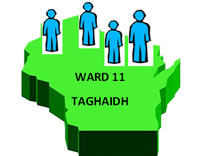 To understand how a Single Transferable (STV) count works lets look at an imaginary Council Ward called Taghaidh.
To understand how a Single Transferable (STV) count works lets look at an imaginary Council Ward called Taghaidh.
Taghaidh is a multi-member ward which is represented by 4 councillors.
One councillor has recently resigned and this leads to a by-election for the 1 vacancy or seat.
How to Complete your Ballot Paper
In this example there are 4 candidates competing for the 1 vacant seat.
On Polling day – voters in the Taghaidh voted by numbering their candidates in order of preference.
They put a 1 next to their favourite candidate, a 2 next to their second favourite, a 3 by their third, and so on…..
Some people chose to number all the candidates; some choose just three or even just one. This is fine, you can number as many or as few as you like.
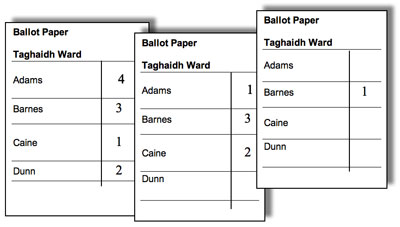
How STV is Counted
Working out the Quota
In this example ward 5000 people cast valid votes; there is 1 seat available and 4 candidates. Before we do anything else we need to work out the number of votes a candidate needs to be elected. This is called the quota.
To calculate the formula we do the following sum:
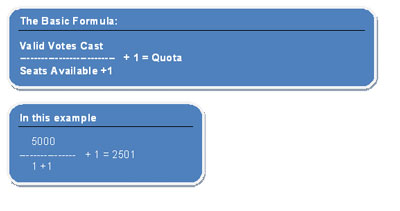
Counting the First Preference
First we count the preferences for each of the 4 candidates. Nobody had more than the quota so we move to the 2nd round.
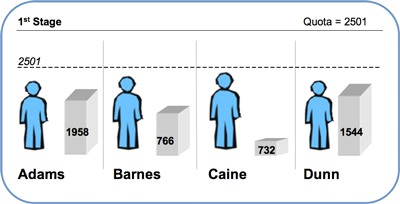
Excluding a Candidate
As no-one met the quota – the candidate with the fewest votes at the 1st stage is removed from the count.
In this instance this was Caine.
Caine’s votes are then checked again to look for the 2nd preference on the ballot paper, dividing them between the remaining candidates.
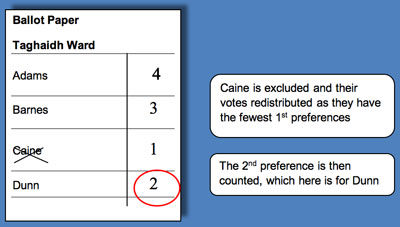
The 2nd Stage Results
This is how it looks after the 2nd Stage.
Of the 732 votes examined, 13 voters indicated a 2nd preference for Barnes taking the total to 779, 429 voters indicated a 2nd preference for Dunn and 194 voters indicated a 2nd preference for Adams. 96 voters only indicated a 1st preference for Caine and made no other mark on the ballot paper so their papers became ‘non-transferable’ at this stage.
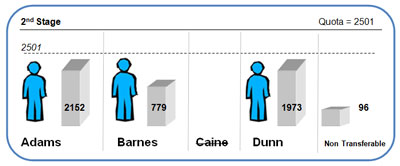
The 3rd Stage
After transferring Caine’s 2nd preferences, still no-one has reached the quota. So once again we take the candidate with the fewest votes at the 2nd stage and this is Barnes.
Barnes’ votes are then examined again to look for the next available preference after Barnes on the ballot paper dividing them between the remaining candidates.
If the next available preference is for a candidate that has already been excluded, i.e. in this example ‘Caine’ then we look for the next preference after that on that ballot paper.
Of the 779 votes examined, 431 voters indicated a 3rd preference for Adams taking the total to 2583, 278 voters indicated a 3rd preference for Dunn taking the total to 2251 and 70 voters had indicated no further preferences and made no other mark on the ballot paper so their papers became ‘non-transferable’ at this stage, making an overall total of 166.
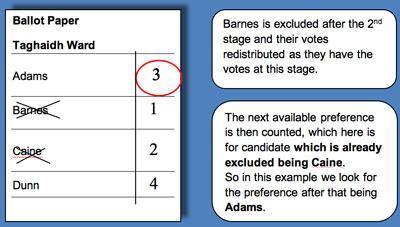
Final Results of the Count
After the 3rd stage Adams received the most votes after the preferences of the excluded candidates were transferred. Adams is now elected to fill the vacancy in the Taghaidh Ward.
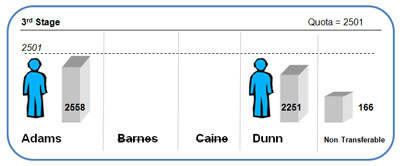
In an STV local government by-election the number of stages is related to the number of candidates who are on the ballot paper and will continue stage by stage until there are two candidates left and the one with the most votes transferred is elected.
In a full STV local government (council) election - where there are 3 / 4 seats are available dependent on the ward being contested, a similar process occurs until either 3 or 4 candidates meet the quota or are left in the contest after other candidates are excluded. Transfers of votes happen in numbers of part decimal point, e.g. 0.528 and as this is complicated to count it is conducted electronically.
